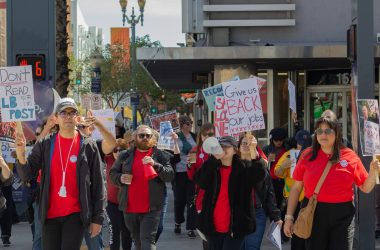Housing prices have skyrocketed; the city streets are always under construction; new and expensive businesses seem to appear overnight. Long Beach is becoming gentrified.
“It’s easy to turn gentrification into the boogeyman, but it many cases it’s been a boon,“ Josh Butler, executive director of Housing Long Beach, said. “I’ve seen areas of Los Angeles that have undergone gentrification, and it’s much improved, but I always ask for whom?”
Gentrification is like a snowball effect where young urban professionals with money who buy property end up driving the cost of living higher and higher, pricing people with low incomes and people of color out of these increasingly whiter and wealthier neighborhoods.
It started in the downtown area some 10 years ago, and with greater economic stability, gentrification has begun spreading at an accelerated rate to neighborhoods like Cambodia Town and North Long Beach.
The average home value in Downtown Long Beach went up from almost $93,000 in 2006 to over $325,000 in 2014, according to the most recent report by the Downtown Long Beach Association, a nonprofit organization that operates on behalf of property owners to improve and develop the downtown area. This may price out lower income buyers and renters.
For entrepreneurs, gentrification is a good sign. Long Beach is a smart investment for business owners or landlords with its relatively low rent, steady growth in purchasing power and eager local developers.
“[Gentrification] is totally torn between cultural disenfranchisement and public safety and sanitation,” DLBA communications manager Brian Addison said.
DLBA calls the downtown renovations a renaissance in its report geared toward attracting more business investors. It boasts a $500,000 contribution to the $6.5 million Pine Avenue Refresh Project that resulted in 25 benches, 33 bike racks, 34 litter receptacles, 42 Pink Trumpet trees, 22 Palm trees and 96 LED pedestrian lights.
However, the report does not address the loss of residents with lower incomes.
There are entirely different people living downtown nowadays, Butler said. “My question is not is it better or worse, it’s where did those people go?”
“Long Beach prides itself on its diversity,” Jorge Rivera, now-former Housing Long Beach community organizer, said in an email. “Because of the increasing property values and increasing rents by wealthier people of middle class status, we are going to see poorer individuals and families pushed out of their neighborhoods. Typically, the poorer communities are people of color. So, if we are asking how it will change the culture, then we will definitely see a severe loss of our coveted diversity.”
When lower income residents are pushed out of their established communities, loss of culture is a serious issue. For example, Long Beach’s Anaheim Corridor once had the largest Cambodian population outside of Cambodia, but gentrification is changing that, Butler said.

Authentic Pho restaurants line the street where community members and Long Beach residents can find their favorite traditional Vietnamese soup dish.
Now, Anaheim Corridor business owners want to bring commercial renovation to the neighborhood, Rivera said. “However, in their discussions to date, they make no mention of the reverberating impacts higher property values will have in the surrounding community.
An assessment by the Southern California Association of Governments calls for the construction of 7,048 units in Long Beach, 43 percent of which will go toward moderate-income level households. Of the total, only 15 percent will be allocated to low-income families.
“This implies that the regional planning agency has determined that there is a greater need to plan for accommodating higher income households,” Long Beach Development Services spokesperson Jacqueline Medina said.
“[Business owners] obviously want to do a good thing and improve the business for the shops in the area, not realizing how, in doing so, they will take away from the what makes the community great as it is, which is the people of the Cambodian community,” Rivera said.
A large number of current Long Beach residents are at risk of displacement.
“Long Beach is by and large a low-income community,” Butler said. “Over one third of Long Beach renters are paying over half their income to rent … When you’re paying over 33 percent of your income to rent, you’re already paying too much.”
The value of housing is also a problem, especially if gentrification affects the ability of low-wage and middle-income workers to live in the neighborhoods near their jobs, according to Christine Jocoy, associate professor with Cal State Long Beach’s Department of Urban Planning, in an email.
“Of course, if developers rather than individual homeowners are the main drivers of the gentrification process, then the developers will likely make money depending on the size of their developments and the prices they can charge,” Jocoy said.
The pricier and more elaborate the development, the more cost of living rises.
“ … Wealthier people will probably bring in more spending, which will produce more revenue, attract new businesses and people, and make the area more economically viable,” Rivera said.
But that economic viability may not benefit those who can no longer afford to live in gentrified neighborhoods.
“With gentrification comes corporate interests, and money will flow out of the city,” said Immigrant Rights Coalition Community Organizer Jonathan Solorzano. “With small businesses, the money tends to stay within the community.”
And when people have to work two and three jobs just to live, they may not have the time or motivation to become politically active or to speak out against housing inequalities.
“It has been documented that the more income equality that exists, the less likely [low income residents] are to be civically engaged in elections or even know who their representatives are,” Solorzano said.
It doesn’t seem like policy makers or neighborhood renovators are making it any easier for current residents to have a say.
“There’s no communication with the community themselves,” Solorzano said. “They want to make a park but they don’t even consult with the local community. [Residents] end up having a park at the end of the day that they don’t even feel belongs to them.”
The current residents feel like the renovations are really for the wealthier residents who will come replace them, Solorzano said.
On the other hand, gentrification could inspire a greater amount of political activism within threatened communities, Jocoy said.
“Some people seek gentrification and feel there are benefits, and there can be [benefits],” Butler said. “We have to ask ourselves as our community changes, what are we doing for our residents that are here now?”
Maybe it’s possible to have the best of both worlds.
Rivera said, “Conscious policy must be sought in order to ensure our lower income residents and people of color are not being adversely affected, as we strive to improve health, safety, affordability and security of our city and communities.”

This Cambodia Town jewelry store is closed despite business hours that list it as being open. As gentrification becomes more pervasive, the Anaheim business corridor will see more and more Southeast Asian stores closing their doors.
This article has been updated to reflect that Jorge Rivera, who was interviewed while still employed with Housing Long Beach as a community organizer, no longer works with the organization.
A version of this article ran in Voicewaves.





The one thing that is missing from this article is reality. Here is reality: If you look at the cities and neighborhoods on the ocean side of the 405 all the way from Malibu to South Orange County, Long Beach remains the most affordable. Good luck finding any 3br/2ba home from PV up to Malibu for under $1M – seriously, try to find one! Then do the same from Seal Beach south to San Juan – nothing under $1M except a few small pockets where the 405 is further from the ocean. So, Long Beach is, by just about any standard, a bargain. And when there is a bargain, bargain hunters will come in and make money. This is just the beginning.
Thank you for this article. When I read about new developments in the Pleasantville papers (like the Post and P-T) I never hear about the ramifications to the working poor. The candidates running for the open 2nd District seat seem to pander to the voters that benefit from gentrification, with talk of more cops–a strategy that essentially criminalizes homelessness and mental illness. I’ve watched my own little street move away from it’s working class roots and is being settled by more white folks and hipsters. As nice as they are, I wonder what happened to the Cambodian and Latino families that owned their homes and collected recycling for a living?